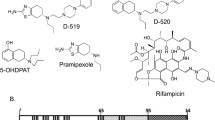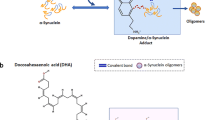Abstract
Aggregated alpha-synuclein (α-SYN) is the major component of Lewy bodies and Lewy neurites, two of the pathological hallmarks of Parkinson’s disease (PD). Aggregation of α-SYN leads to toxic species involved in the degeneration of dopaminergic neurons in the midbrain. Different studies suggest a strong association between the presence of dopamine (DA) and the cell specific degeneration caused by α-SYN aggregates in PD. Despite extensive studies on the effect of DA on α-SYN fibrillation, it remains unclear how the simultaneous presence of DA and α-SYN influences the degeneration of dopaminergic neurons. In this study we show that separate treatments with specific doses of DA or early stage α-SYN aggregates (ESAA) are both cytotoxic to PC12 cells. Surprisingly, simultaneous treatment of cells with DA and ESAA significantly decreased this toxicity. This cytotoxicity was further reduced by the presence of heavier particles of α-SYN aggregates with more fibrillogenic characteristics. Spectrometric analysis revealed that α-SYN fibrils interact with DA even after the sample was dialyzed for 48 h, suggesting a strong interaction. Interestingly, digestion of unprotected N- and C-α-SYN-fibril terminals by proteinase K did not affect this interaction. Our results suggest that fibrillar forms of α-SYN with localized expanded active surfaces may interact with DA and moderate its cytotoxicity. Thus, highlighting the importance of fibrillar proteins in developing clinical approaches for amyloid diseases.







Similar content being viewed by others
Abbreviations
- AFM:
-
Atomic Force Microscopy
- α-SYN:
-
α-Synuclein
- CD:
-
Circular Dichroism
- DA:
-
Dopamine
- DAQ:
-
Dopamine quinone
- ESAA:
-
Early Stages α-SYN Aggregates
- FTIR:
-
Fourier Transform infrared
- MTT:
-
3-(4,5-dimethythiazol-2-yl)-2,5-diphenyl tetrazolium bromide
- OD:
-
Optical Density
- PD:
-
Parkinson’s Disease
- PK:
-
Proteinase K
- PI:
-
Propidium Iodide
- ROS:
-
Reactive Oxygen Species
- SNpc:
-
Substantia Nigra pars compacta
- ThT:
-
Thioflavin T
References
Lees AJ, Hardy J, Revesz T (2009) Parkinson’s disease. Lancet 373(9680):2055–2066
Spillantini MG, Schmidt ML, Lee VM, Trojanowski JQ, Jakes R, Goedert M (1997) Alpha-synuclein in lewy bodies. Nature 388(6645):839–840
Kayed R, Head E, Thompson JL, McIntire TM, Milton SC, Cotman CW, Glabe CG (2003) Common structure of soluble amyloid oligomers implies common mechanism of pathogenesis. Science 300(5618):486–489
Volles MJ, Lee SJ, Rochet JC, Shtilerman MD, Ding TT, Kessler JC, Lansbury PT Jr (2001) Vesicle permeabilization by protofibrillar alpha-synuclein: implications for the pathogenesis and treatment of Parkinson’s disease. Biochemistry 40(26):7812–7819
Gosavi N, Lee HJ, Lee JS, Patel S, Lee SJ (2002) Golgi fragmentation occurs in the cells with prefibrillar alpha-synuclein aggregates and precedes the formation of fibrillar inclusion. J Biol Chem 277(50):48984–48992
Chinta SJ, Mallajosyula JK, Rane A, Andersen JK (2010) Mitochondrial alpha-synuclein accumulation impairs complex i function in dopaminergic neurons and results in increased mitophagy in vivo. Neurosci Lett 486(3):235–239
Freundt EC, Maynard N, Clancy EK, Roy S, Bousset L, Sourigues Y, Covert M, Melki R, Kirkegaard K, Brahic M (2012) Neuron-to-neuron transmission of alpha-synuclein fibrils through axonal transport. Ann Neurol 72(4):517–524
Jang A, Lee HJ, Suk JE, Jung JW, Kim KP, Lee SJ (2010) Non-classical exocytosis of alpha-synuclein is sensitive to folding states and promoted under stress conditions. J Neurochem 113(5):1263–1274
Desplats P, Lee HJ, Bae EJ, Patrick C, Rockenstein E, Crews L, Spencer B, Masliah E, Lee SJ (2009) Inclusion formation and neuronal cell death through neuron-to-neuron transmission of alpha-synuclein. Proc Natl Acad Sci USA 106(31):13010–13015
Braak H, Rub U, Gai WP, Del Tredici K (2003) Idiopathic Parkinson’s disease: possible routes by which vulnerable neuronal types may be subject to neuroinvasion by an unknown pathogen. J Neural Transm 110(5):517–536
Pan-Montojo F, Schwarz M, Winkler C, Arnhold M, O’Sullivan GA, Pal A, Said J, Marsico G, Verbavatz JM, Rodrigo-Angulo M, Gille G, Funk RH, Reichmann H (2012) Environmental toxins trigger pd-like progression via increased alpha-synuclein release from enteric neurons in mice. Sci Rep 2:898
Nemani VM, Lu W, Berge V, Nakamura K, Onoa B, Lee MK, Chaudhry FA, Nicoll RA, Edwards RH (2010) Increased expression of alpha-synuclein reduces neurotransmitter release by inhibiting synaptic vesicle reclustering after endocytosis. Neuron 65(1):66–79
Yavich L, Tanila H, Vepsalainen S, Jakala P (2004) Role of alpha-synuclein in presynaptic dopamine recruitment. J Neurosci 24(49):11165–11170
Lotharius J, Brundin P (2002) Impaired dopamine storage resulting from alpha-synuclein mutations may contribute to the pathogenesis of Parkinson’s disease. Hum Mol Genet 11(20):2395–2407
Taylor TN, Alter SP, Wang M, Goldstein DS, Miller GW (2014) Reduced vesicular storage of catecholamines causes progressive degeneration in the locus ceruleus. Neuropharmacology 76 Pt A:97–105
Asanuma M, Miyazaki I, Ogawa N (2003) Dopamine- or l-dopa-induced neurotoxicity: the role of dopamine quinone formation and tyrosinase in a model of Parkinson’s disease. Neurotox Res 5(3):165–176
Junn E, Mouradian MM (2002) Human alpha-synuclein over-expression increases intracellular reactive oxygen species levels and susceptibility to dopamine. Neurosci Lett 320(3):146–150
Maker HS, Weiss C, Silides DJ, Cohen G (1981) Coupling of dopamine oxidation (monoamine oxidase activity) to glutathione oxidation via the generation of hydrogen peroxide in rat brain homogenates. J Neurochem 36(2):589–593
Hastings TG (2009) The role of dopamine oxidation in mitochondrial dysfunction: implications for Parkinson’s disease. J Bioenerg Biomembr 41(6):469–472
Miyazaki I, Asanuma M (2009) Approaches to prevent dopamine quinone-induced neurotoxicity. Neurochem Res 34(4):698–706
LaVoie MJ, Ostaszewski BL, Weihofen A, Schlossmacher MG, Selkoe DJ (2005) Dopamine covalently modifies and functionally inactivates parkin. Nat Med 11(11):1214–1221
Emdadul Haque M, Asanuma M, Higashi Y, Miyazaki I, Tanaka K, Ogawa N (2003) Apoptosis-inducing neurotoxicity of dopamine and its metabolites via reactive quinone generation in neuroblastoma cells. Biochim Biophys Acta 1619(1):39–52
Conway KA, Rochet JC, Bieganski RM, Lansbury PT Jr (2001) Kinetic stabilization of the alpha-synuclein protofibril by a dopamine-alpha-synuclein adduct. Science 294(5545):1346–1349
Leong SL, Pham CL, Galatis D, Fodero-Tavoletti MT, Perez K, Hill AF, Masters CL, Ali FE, Barnham KJ, Cappai R (2009) Formation of dopamine-mediated alpha-synuclein-soluble oligomers requires methionine oxidation. Free Radic Biol Med 46(10):1328–1337
Mazzulli JR, Armakola M, Dumoulin M, Parastatidis I, Ischiropoulos H (2007) Cellular oligomerization of alpha-synuclein is determined by the interaction of oxidized catechols with a c-terminal sequence. J Biol Chem 282(43):31621–31630
Fink AL (2006) The aggregation and fibrillation of α-synuclein. Acc Chem Res 39(9):628–634
Chiti F, Dobson CM (2006) Protein misfolding, functional amyloid, and human disease. Annu Rev Biochem 75:333–366
Kaylor J, Bodner N, Edridge S, Yamin G, Hong DP, Fink AL (2005) Characterization of oligomeric intermediates in alpha-synuclein fibrillation: fret studies of y125w/y133f/y136f alpha-synuclein. J Mol Biol 353(2):357–372
Jana S, Sinha M, Chanda D, Roy T, Banerjee K, Munshi S, Patro BS (1812) Chakrabarti S (2011) Mitochondrial dysfunction mediated by quinone oxidation products of dopamine: implications in dopamine cytotoxicity and pathogenesis of Parkinson’s disease. Biochim Biophys Acta 6:663–673
Berman SB, Hastings TG (1999) Dopamine oxidation alters mitochondrial respiration and induces permeability transition in brain mitochondria: implications for Parkinson’s disease. J Neurochem 73(3):1127–1137
Luth ES, Stavrovskaya IG, Bartels T, Kristal BS, Selkoe DJ (2014) Soluble, prefibrillar α-synuclein oligomers promote complex i-dependent, Ca2+-induced mitochondrial dysfunction. Journal of Biological Chemistry:jbc. M113:545749
Silva BA, Einarsdottir O, Fink AL, Uversky VN (2013) Biophysical characterization of alpha-synuclein and rotenone interaction. Biomolecules 3(3):703–732
Halliwell B, Gutteridge JMC (1985) Oxygen radicals and the nervous system. Trends Neurosci 8:22–26
Storch A, Blessing H, Bareiss M, Jankowski S, Ling ZD, Carvey P, Schwarz J (2000) Catechol-o-methyltransferase inhibition attenuates levodopa toxicity in mesencephalic dopamine neurons. Mol Pharmacol 57(3):589–594
Schubert D, Behl C, Lesley R, Brack A, Dargusch R, Sagara Y, Kimura H (1995) Amyloid peptides are toxic via a common oxidative mechanism. Proc Natl Acad Sci USA 92(6):1989–1993
Demuro A, Mina E, Kayed R, Milton SC, Parker I, Glabe CG (2005) Calcium dysregulation and membrane disruption as a ubiquitous neurotoxic mechanism of soluble amyloid oligomers. J Biol Chem 280(17):17294–17300
Giehm L, Svergun DI, Otzen DE, Vestergaard B (2011) Low-resolution structure of a vesicle disrupting α-synuclein oligomer that accumulates during fibrillation. Proc Natl Acad Sci USA 108(8):3246–3251
Volles MJ, Lansbury PT Jr (2003) Zeroing in on the pathogenic form of alpha-synuclein and its mechanism of neurotoxicity in Parkinson’s disease. Biochemistry 42(26):7871–7878
Danzer KM, Haasen D, Karow AR, Moussaud S, Habeck M, Giese A, Kretzschmar H, Hengerer B, Kostka M (2007) Different species of alpha-synuclein oligomers induce calcium influx and seeding. J Neurosci 27(34):9220–9232
Cappai RL, Leck SL, Tew DJ, Williamson NA, Smith DP, Galatis D, Sharples RA, Curtain CC, Ali FE, Cherny RA, Culvenor JG, Bottomley SP, Masters CL, Barnham KJ, Hill AF (2005) Dopamine promotes alpha-synuclein aggregation into sds-resistant soluble oligomers via a distinct folding pathway. FASEB J 19:1377–1379
Norris EH, Giasson BI, Hodara R, Xu S, Trojanowski JQ, Ischiropoulos H, Lee VM (2005) Reversible inhibition of alpha-synuclein fibrillization by dopaminochrome-mediated conformational alterations. J Biol Chem 280(22):21212–21219
Pham CL, Cappai R (2013) The interplay between lipids and dopamine on alpha-synuclein oligomerization and membrane binding. Biosci Rep 33(5):807–814
Morshedi D, Mohammadi Z, Akbar Boojar MM, Aliakbari F (2013) Using protein nanofibrils to remove azo dyes from aqueous solution by the coagulation process. Coll Surf B Biointerfaces 112:245–254
Jones SR, Gainetdinov RR, Jaber M, Giros B, Wightman RM, Caron MG (1998) Profound neuronal plasticity in response to inactivation of the dopamine transporter. Proc Natl Acad Sci USA 95(7):4029–4034
Chen L, Ding Y, Cagniard B, Van Laar AD, Mortimer A, Chi W, Hastings TG, Kang UJ, Zhuang X (2008) Unregulated cytosolic dopamine causes neurodegeneration associated with oxidative stress in mice. J Neurosci 28(2):425–433
Cyr M, Beaulieu JM, Laakso A, Sotnikova TD, Yao WD, Bohn LM, Gainetdinov RR, Caron MG (2003) Sustained elevation of extracellular dopamine causes motor dysfunction and selective degeneration of striatal gabaergic neurons. Proc Natl Acad Sci USA 100(19):11035–11040
Hastings TG, Lewis DA, Zigmond MJ (1996) Role of oxidation in the neurotoxic effects of intrastriatal dopamine injections. Proc Natl Acad Sci USA 93(5):1956–1961
Koshimura K, Tanaka J, Murakami Y, Kato Y (2000) Effects of dopamine and l-dopa on survival of pc12 cells. J Neurosci Res 62(1):112–119
Zhou W, Gallagher A, Hong DP, Long C, Fink AL, Uversky VN (2009) At low concentrations, 3,4-dihydroxyphenylacetic acid (dopac) binds non-covalently to alpha-synuclein and prevents its fibrillation. J Mol Biol 388(3):597–610
Corvaglia S, Sanavio B, Hong Enriquez RP, Sorce B, Bosco A, Scaini D, Sabella S, Pompa PP, Scoles G, Casalis L (2014) Atomic force microscopy based nanoassay: a new method to study alpha-synuclein-dopamine bioaffinity interactions. Sci Rep 4:5366
Acknowledgments
This work was supported by the National Institute of Genetic Engineering and Biotechnology.
Author information
Authors and Affiliations
Corresponding author
Ethics declarations
Conflict of interest
The authors declare no potential conflict of interest.
Electronic supplementary material
Below is the link to the electronic supplementary material.
10930_2015_9625_MOESM1_ESM.pdf
Study of ASN fibrillation. Kinetic of the fibrillation monitored by (a) changes in ThT fluorescence intensity or (b) Congo red absorbance. The inset indicates maximum intensity of fluorescence. (c) Far-UV CD spectra of ASN obtained after 0-hours and 48-hours. (d) Fluorescence images of ASN fibrils dyed with ThT (PDF 214 kb)
Rights and permissions
About this article
Cite this article
Khalife, M., Morshedi, D., Aliakbari, F. et al. Alpha-Synuclein Fibrils Interact with Dopamine Reducing its Cytotoxicity on PC12 Cells. Protein J 34, 291–303 (2015). https://doi.org/10.1007/s10930-015-9625-y
Published:
Issue Date:
DOI: https://doi.org/10.1007/s10930-015-9625-y




